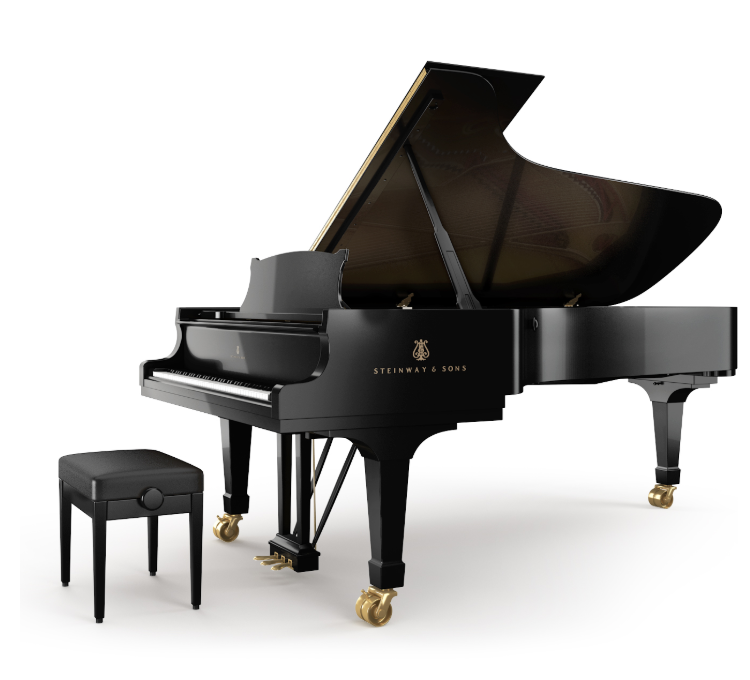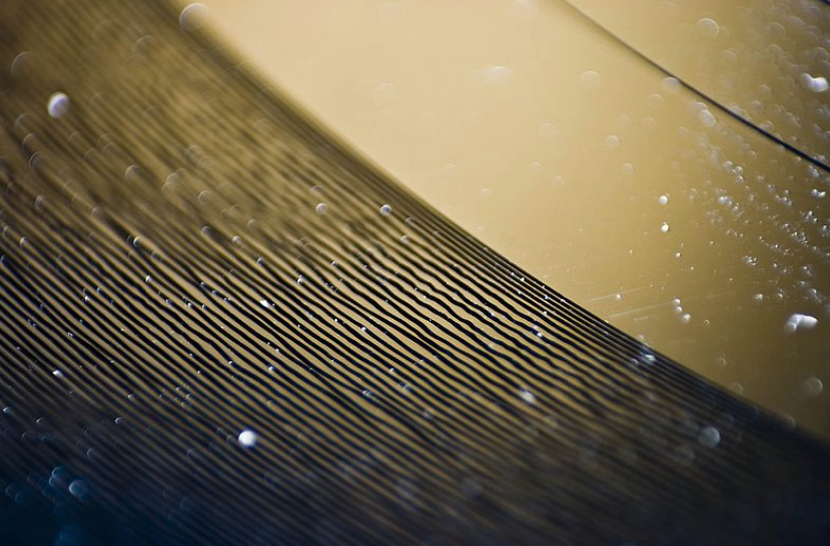(Traumerei – Schumann playing in the background: https://www.youtube.com/watch?v=fHlfNYY1YIY)
Sixty thousand pounds is the weight of five fully-grown elephants and the amount of force contained within a concert grand piano. [1] Although it’s been around for over three centuries, the piano has evolved into one of the most versatile and complex instruments ever. It is the product of many different disciplines acting together and contributing to its design in harmony. A grand piano is truly a work of art, but its flexibility as an instrument and its sheer intricacy also make it a feat of engineering.
Introduction
If you ask a group of musicians whether a piano is a stringed or percussion instrument, expect a wide array of answers. Some will cite the fact that they are typically grouped with percussion instruments in most orchestras [1], but others will say that their production of sound with vibrating strings makes them stringed instruments. To sum up the entire controversy: it’s complicated. As is the piano itself.
The first piano was invented over 300 years ago by an Italian harpsichord repairman. It was initially called the pianoforte – Italian for “soft-loud” – because it was the first keyboard instrument with the ability to play quietly or loudly based on how strongly a key is hit. [2] For the time period, this was a stunning technological development, so it wasn’t long before pianos furnished the homes of every aristocrat who could afford one. [2] Pianos were soon incorporated into orchestras, and as they became more popular, they also became more advanced. Throughout the sixteenth and seventeenth centuries, the piano went through a series of rapid changes: keys were appended to expand its range; piano makers began using iron, which strengthened the instrument and allowed it to be played louder and softer; and pedals were added to create different sounds. [3]
Around the time of the industrial revolution, piano craftsmen were replaced with factories and the design behind a piano has stayed fairly constant since then. [2] Today, pianos are cheap enough that they are accessible to almost anyone. They are currently the most popular musical instrument in America, the home to 21 million active piano players. [4]
General Anatomy
The internal anatomy of a grand piano can be divided into three basic parts: a “soundboard” that amplifies the sound of the strings, a “piano harp” that keeps the strings taut and holds their tension, and an “action” that converts the force of pressing a key into the force of a hammer hitting a string. There is a high level of precision required to reach a piano’s full potential. Changing the schematic even a little could compromise the quality of sound or the entire structural integrity of the instrument.
Essentially, an upright piano is a compact, cheaper alternative to a grand piano, and most of its departures from grand piano designs stem from an effort to save as much space as possible. However, grand pianos are largely regarded as the best-quality pianos, so I will discuss the engineering behind them throughout this article.
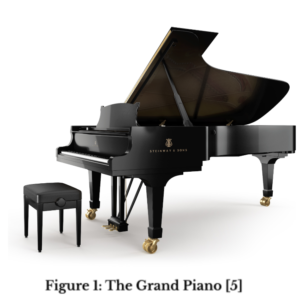
Grand pianos usually have three legs and three pedals, as in the image above, with eighty-eight keys. All grand pianos have a signature curved shape to accommodate the varying lengths of strings on the inside. On top of the curved body, the adjustable top can be lifted to make the instrument louder.
Soundboard (https://www.youtube.com/watch?v=C-Bn70PpbrM, 9:34 – 9:39)
Have you ever stretched out a rubber band as tightly as you could and plucked it like a guitar string? If so, then you’d know that the sound produced is barely audible compared to, for example, a softly-strummed guitar string. This is due to a property called resonance: vibrations caused in a material by another oscillating material. The rubber band is nearly silent because it can only transfer its vibrations to the air, which has very low resonance. The guitar string, on the other hand, is connected to the wooden body of the guitar, which resonates very nicely, resulting in a much louder sound, even when the string is strummed lightly.
In the video above [6], a tuning fork is placed in two different settings. First, it is struck in midair and then its base is placed onto a wooden table. As the audio makes clear, it sounds much louder against the table. This is because vibrations from the tuning fork resonate in the table, thereby amplifying the sound at that frequency.
The tuning fork in the video is the perfect analogy for the inner workings of a piano. Instead of metal tines, a piano contains steel strings and the plank of wood that amplifies that string’s sound is the “soundboard.” Like many other instruments, pianos have soundboards made out of some type of softwood, due to the material’s superior resonant qualities. [7]
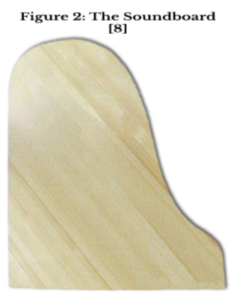
Science isn’t too clear on what type of wood creates the “best” sound or resonates in the most appealing way, but it is clear that certain woods sound better than others due to the geometry of their grain lines, where sound travels along it. [7] Spruce wood creates a very pleasant tone due to its straight grain lines that allow sound to travel faster and resonate better, so most piano makers use spruce to create the soundboard. Also, spruce is sturdier than many other softwoods, so in addition to producing the best sound, spruce’s hardiness supports the structural integrity of the piano harp. [8]
Piano Harp
Also known as a piano “frame” or “plate,” the essential part of the piano called the “piano harp” explains the sideways-harp-like shape that every grand piano has in common. This component, located directly above the soundboard, bears the brunt of the 30 tons of tension exerted by the strings.
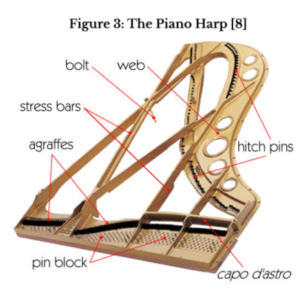
Surprisingly, the engineering of this component was more of a materials science problem than a structural engineering one. In the 1700s, when the first pianos were being manufactured, these parts used to be made from wood. Nowadays, cast iron is used to create the piano harp based on considerations of resonance and tensile strength. Tensile strength refers to a material’s ability to withstand tension without breaking, and cast iron is relatively strong compared to other metals, making it a suitable material for a piano harp, especially with stress bars to reinforce it.
However, not all cast iron is alike, and different piano manufacturers use slightly different blends of cast iron and carbon-based materials (like graphene). [9] This is where resonance comes into play; even though the soundboard is where each note resonates the most, vibrations are transferred most efficiently through contact. Transferring vibrations from the strings to the soundboard through the air is significantly less efficient than transferring vibrations through the piano harp, which is in contact with the strings and the soundboard. Pure cast iron would hinder this process, so piano makers create their own blend of cast iron with other materials to optimize its resonance while sacrificing as little tensile strength as possible.
To actually create the piano harp, high end piano manufacturers like Steinway use the “sand casting” technique, which consists of taking a model of the desired shape and coating it with chemically-treated sand. [9] This sand hardens to form a mold that molten iron is then poured into, and later cooled. Once the iron solidifies, the sand is broken off, leaving behind a metal cast identical in shape to the model. [9] When the cast is complete, holes are drilled along one edge for the hitch pins – metal stubs where the strings attach and can be tightened.
Any discussion of the piano harp would be incomplete without also talking about the strings it holds in place. The vast majority of pianos have 230 piano strings – most notes have three strings each, but the lowest ones have only one or two strings each. The piano strings (also called “piano wires”) each must carry roughly 200 pounds of tension, so they are made from high-tensile steel wire due to the material’s exceptional tensile strength. [8] The strings for each note have different lengths and diameters, specified to match a certain pitch. Strings that are thinner and shorter play higher notes, while strings that are thicker and longer play lower notes. This phenomenon is due to the speed of the string vibrations: thicker, longer strings move more slowly than thin, short strings, so they have a lower frequency, which results in a lower sound. [8]

Action
Simply put, the action is the mechanism in a piano that transfers the force of a finger striking a key into the force of the hammer striking the string. Yet, this mechanism is not simple, as there are many complexities involved in producing the varied and beautiful music of the piano.
How do the pedals physically change the sound? How does the hammer fall away from the string after the initial strike even if the note is held? How is the string silenced when the key is no longer pressed down? To answer these questions, we must first think about what we want to accomplish when a piano key is struck.
We want the hammer to hit the note when the key is pressed. Essentially, each key is a lever, so when the key is struck, the hammer underneath the corresponding string strikes that string to produce a note. However, according to this explanation, the hammer would stay in contact with the string for however long the note is pressed, which would hinder the string’s ability to vibrate and produce sound. [11] So, we also need the hammer to fall away immediately after coming into contact with the string, which is accomplished by detaching the hammer from the lever and inserting a spring between the two pieces. This allows the hammer to extend past its reach for just a moment, thereby hitting the string and immediately letting go.
Then, when we are done playing our note, we don’t want the strings to vibrate forever, so for this reason, there is a small felt “damper” attached to the initial lever that stifles the string’s vibrations as soon as the key is released. [11] If you are playing one of the many songs that requires the note to be held after it is released, you can simply press down on the right pedal (or “sustaining pedal”), which simultaneously raises all of the dampers and lets all strings that are struck vibrate freely until the pedal is released.
Looking at the three mechanisms of the instrument as a whole, when a note is pressed, the action causes the hammer to hit the corresponding strings. These strings – stretched and held in place by the piano harp – begin to vibrate, and these vibrations get transferred through the piano harp to the soundboard, where the sound gets amplified due to resonance. Fit all of this into a sleek, harp-shaped body and you have a grand piano!
Conclusion
Though the arts and sciences are widely regarded as two very separate subjects, the piano would not be possible without structural engineering or materials science. It brings together mechanical engineering, civil engineering, physics, chemistry, and creativity to form perhaps the most versatile instrument ever. The Fur Elise and other pinnacle musical achievements are not just artistic masterpieces, but engineering feats.
References
[1] D. Stone, “10 Interesting Facts About The Piano,” Normans News, 02-Mar-2015. [Online]. Available: http://www.normans.co.uk/blog/2015/03/10-interesting-facts-piano/. [Accessed: 30-Apr-2018].
[2] C. A. Hoover, P. Rucker, and E. M. Good, Piano 300: celebrating three centuries of people and pianos. Washington, D.C.: National Museum of American History, Behring Center, Smithsonian Institution, 2001.
[3] Piano Notes: History. [Online]. Available: http://iml.jou.ufl.edu/projects/Fall05/pfaff/history.html. [Accessed: 30-Apr-2018].
[4] J. Burns, “Electric guitar overtakes violin in music lesson boom,” BBC News, 15-Sep-2014. [Online]. Available: http://www.bbc.com/news/education-29117849. [Accessed: 30-Apr-2018].
[5] “Steinway & Sons,” Wikipedia, 19-Apr-2018. [Online]. Available: https://en.wikipedia.org/wiki/Steinway_&_Sons#/media/File:Steinway_&_Sons_concert_grand_piano,_model_D-274,_manufactured_at_Steinway’s_factory_in_Hamburg,_Germany.png. [Accessed: 30-Apr-2018].
[6] J. S. Miller, “Lesson 34 – Resonance – Forced Vibrations – Demonstrations in Physics,” YouTube, 03-Feb-2014. [Online]. Available: http://www.youtube.com/watch?v=C-Bn70PpbrM. [Accessed: 30-Apr-2018].
[7] B. Cole, “Reasons to Use Sitka Spruce for Your Soundboard,” Alaska Specialty Woods, 10-Jan-2018. [Online]. Available: https://alaskawoods.com/reasons-to-use-sitka-spruce-for-your-soundboard/. [Accessed: 30-Apr-2018].
[8] “The Piano Deconstructed,” The Piano Deconstructed. [Online]. Available: http://www.piano.christophersmit.com/frame.html. [Accessed: 30-Apr-2018].
[9] “Cast Iron Piano Plate | Steinway Piano Parts – Chupp’s Piano Service,” New & Used Pianos | Restorations | Steinway, Yamaha, & More. [Online]. Available: http://www.chuppspianos.com/services/grand-piano-parts/plate/. [Accessed: 30-Apr-2018].
[10] L. Fine, “A Little Bit of the Technical,” PianoWorld. [Online]. Available: http://www.pianoworld.com/Buying_A_Piano/Buying_A_Acoustic_Piano_2.html. [Accessed: 30-Apr-2018].
[11] M. Hammer, The Anatomy of a Piano. [Online]. Available: http://www.pianonoise.com/Article.Piano.htm. [Accessed: 30-Apr-2018].

